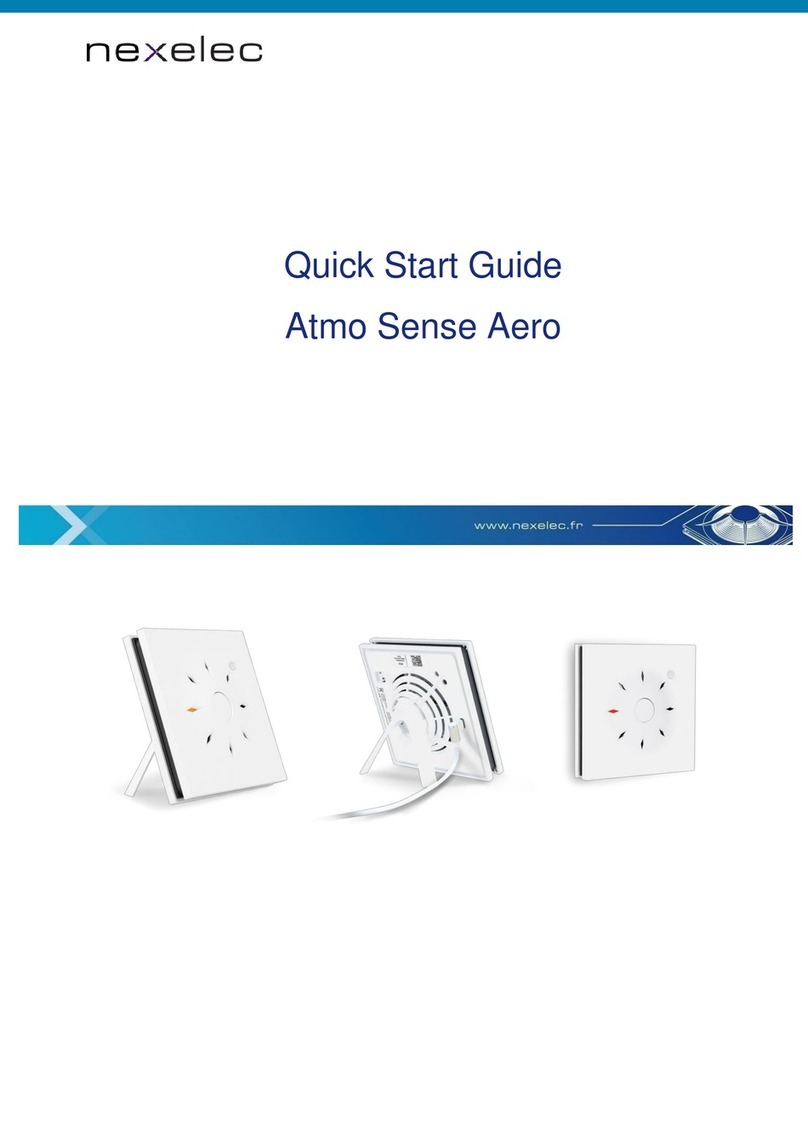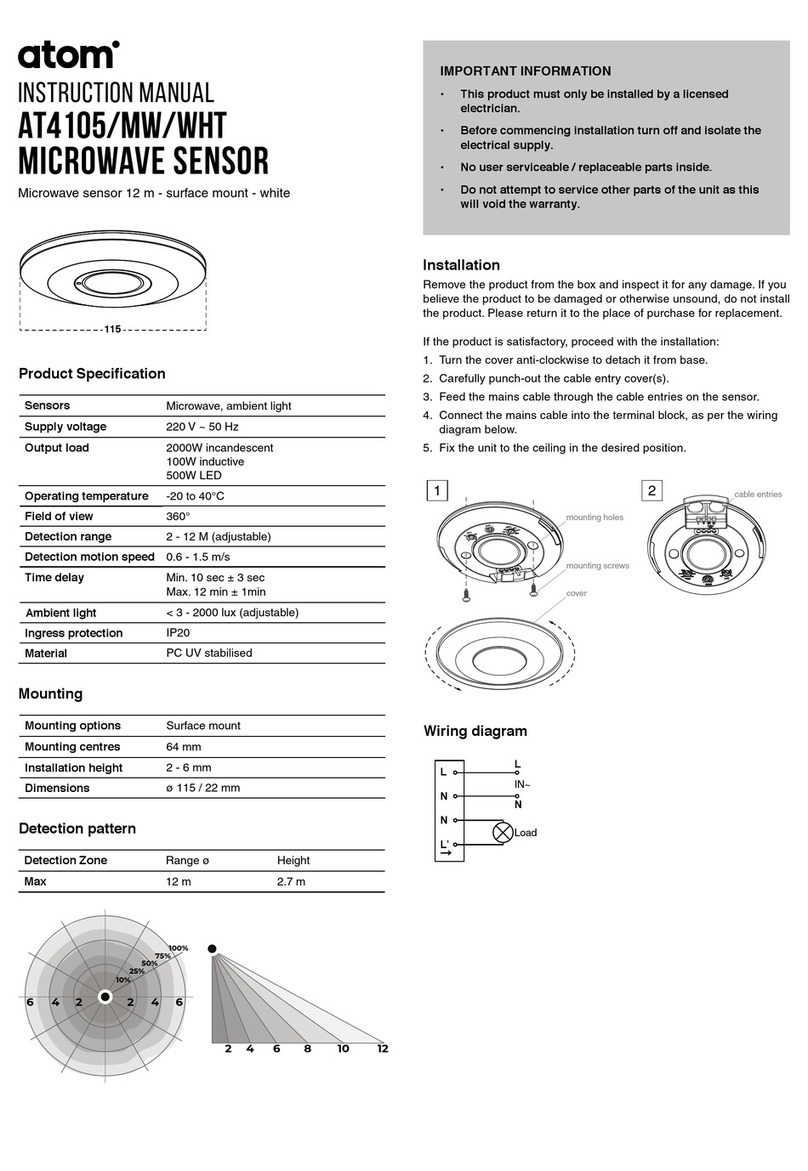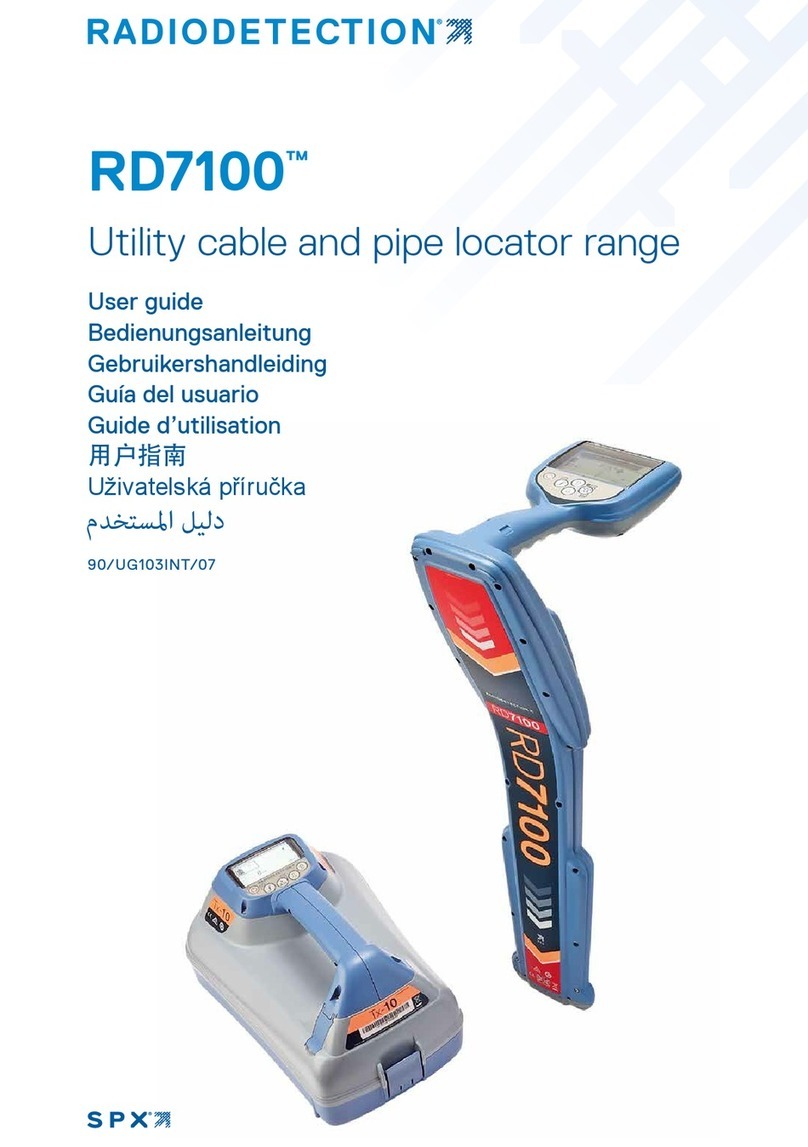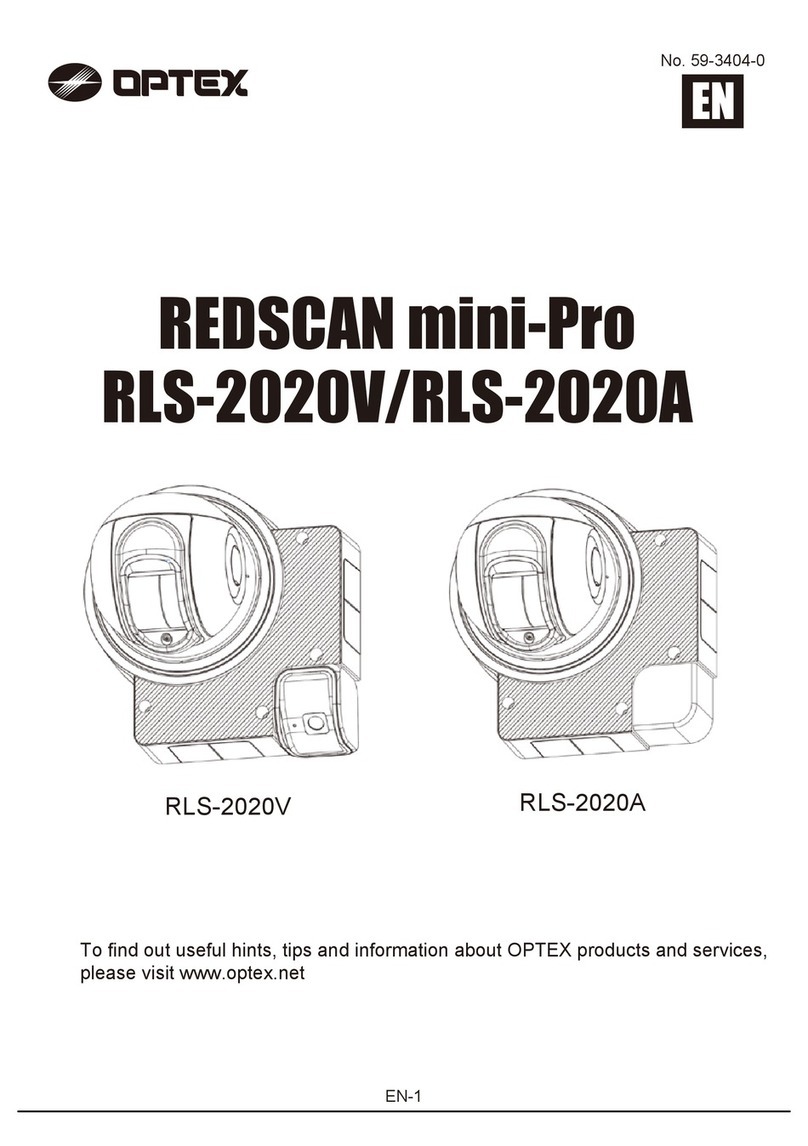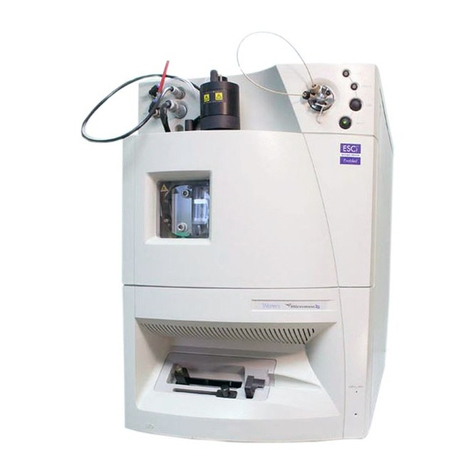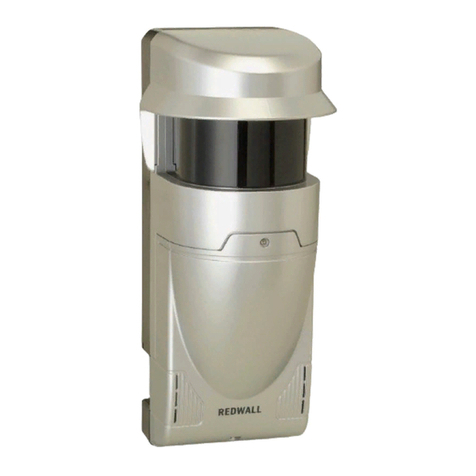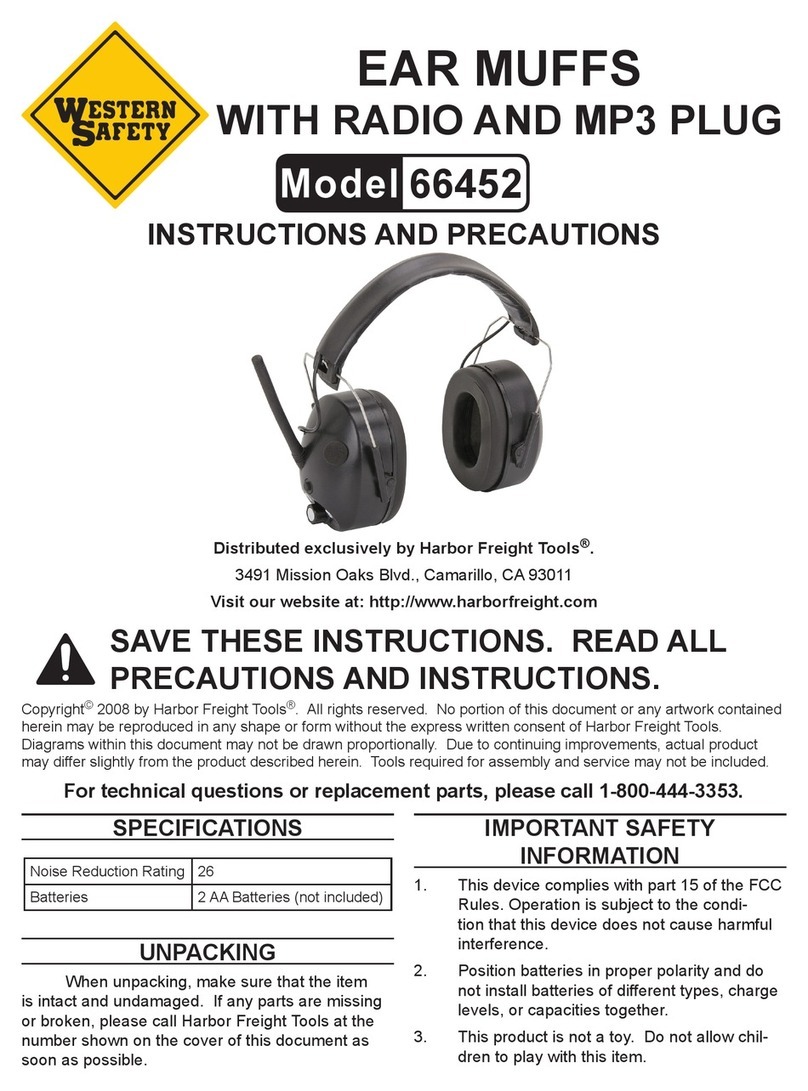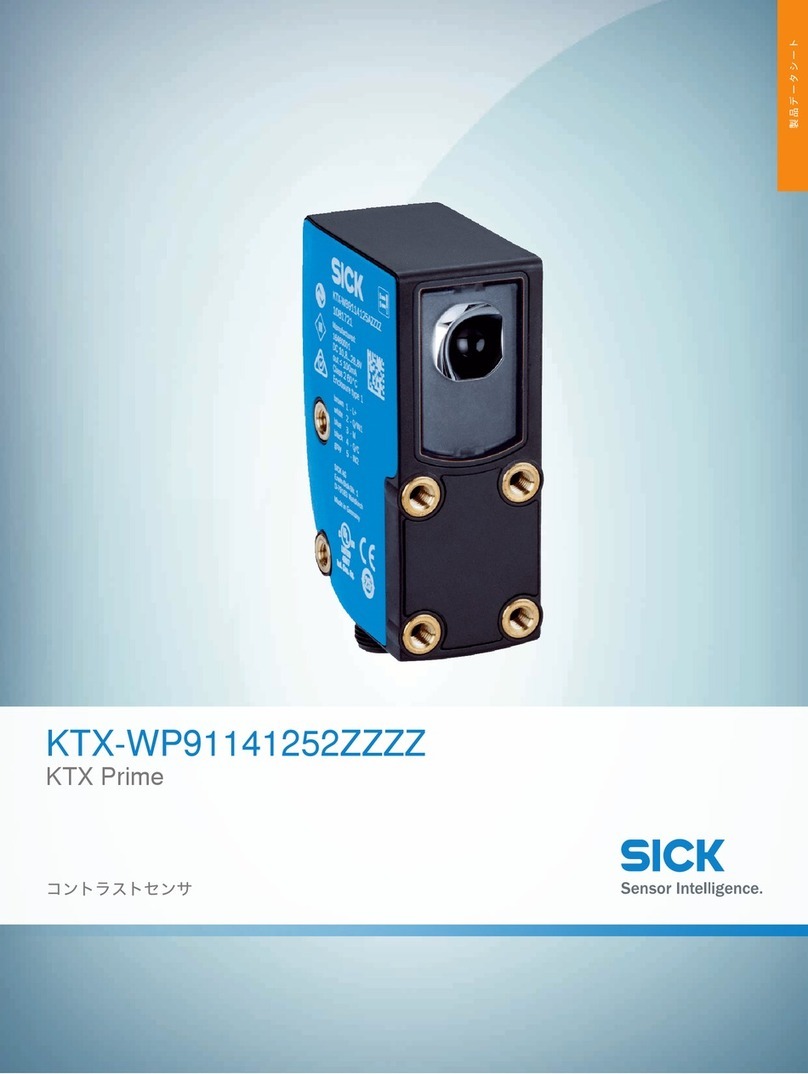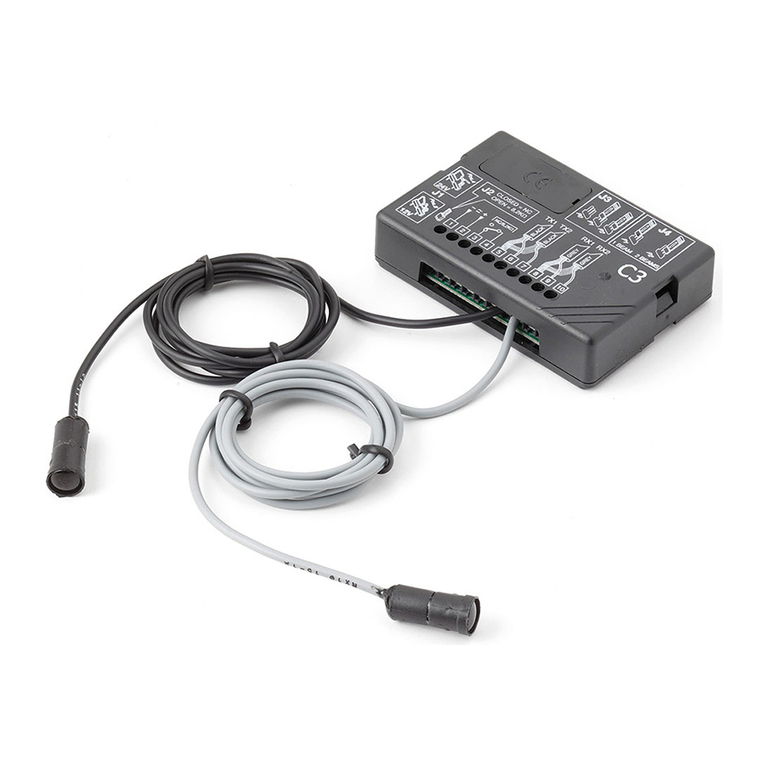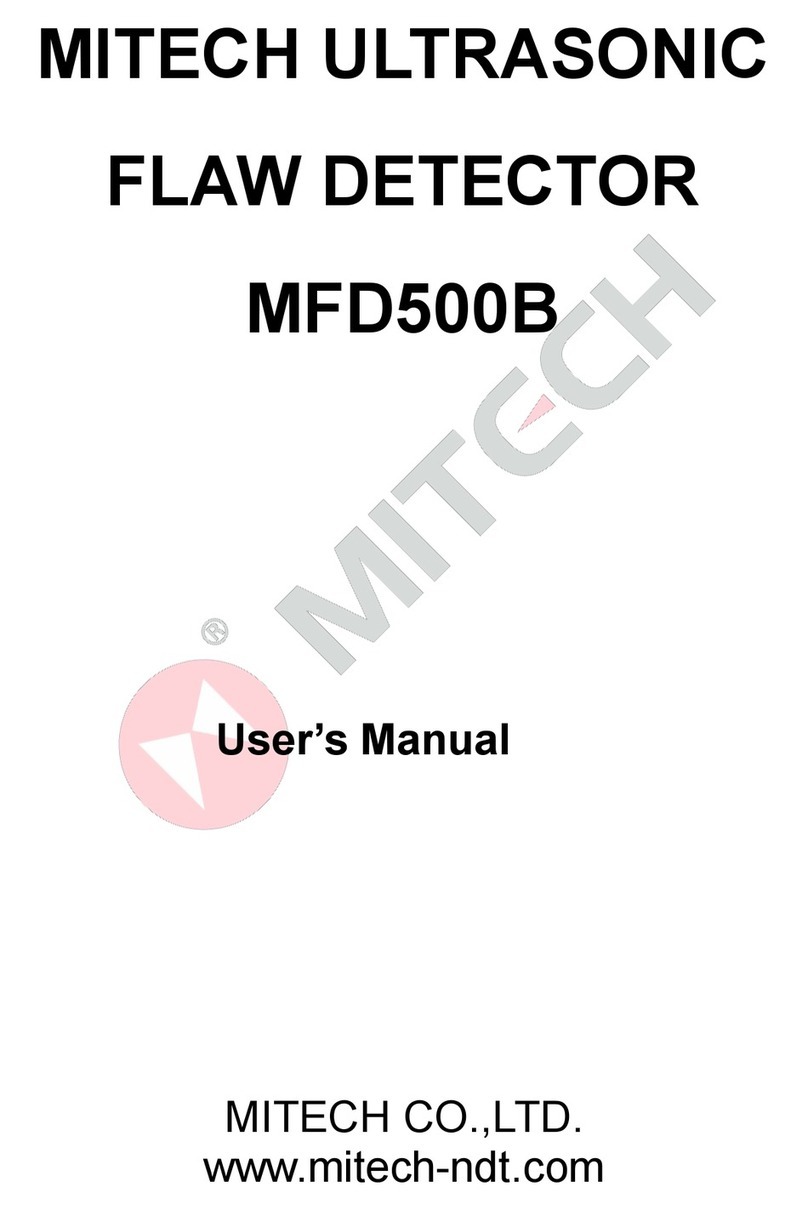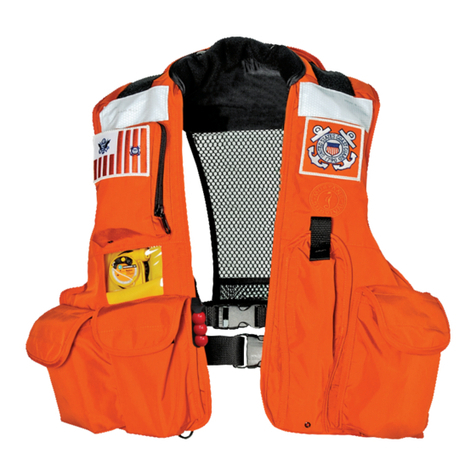Nexelec INSAFE Air User manual


1. DESCRIPTION OF THE INSAFE AIR DETECTOR
A carbon monoxide (CO) detector is an alarm system designed to trigger an early alarm if a low level of CO is
detected via its built-in audio signal.
INSAFE Air is a standalone household carbon monoxide detector with a built-in alarm system (DAACO).
Your detector and its sealed lithium battery come with a 10-year life.
INSAFE Air
Product model: I335CM
EN50291-1 :2010
EN50291-1/A1 :2012
Dimensions: 105x105x30 mm
Storage temperature: between -10°C and +40°C
Standard operating temperature: between +10°C and +40°C
Humidity: from 15% to 95%
The detector can be used in an exceptional household environment:
Operating temperature: between -10°C and +40°C.
Recurrent and/or extended use in this environment can reduce the life of the battery and therefore the
autonomy of the detector.
Warning
The detector must be installed by a qualied individual, according to the instructions given in this manual.
The detector will only activate the alarm in due time if properly located, installed and maintained.
Under no circumstances can the detector be considered to replace the appropriate installation, use and mainte-
nance of your fuel-operated device.
Your INSAFE Air detector complies with standard EN50291-1. However, this standard does not protect the people
who are particularly vulnerable to carbon monoxide exposure, such as young children, pregnant women and
people suffering from cardiac or respiratory disorders.
2. CARBON MONOXIDE: HAZARD AND ORIGIN
Carbon monoxide is a particularly toxic, colourless, odourless, non-irritating gas. This gas is released by
defective fuel-operated devices or by blocked evacuation or ventilation systems.
Potential sources of carbon monoxide:
- Gas, coal or fuel oil heating devices
- Wood res
- Wood and gas boilers
- Gas cooking hobs
- Barbecues
- Blocked chimneys and smoke stacks
- Tobacco smoke
INSAFE Air
Carbon monoxide detector
USER MANUAL
Read this manual carefully before use.
Keep all documentation supplied throughout
the entire service life of the product.
EN

The toxic effects of carbon monoxide:
If you experience any of the following symptoms, contact your doctor.
C0 concentration Effects
100 ppm Minor headaches, weakness, nausea
200 ppm Serious headaches, nausea, slowed limb movements.
400 ppm Dizziness, nausea, reduced visual acuity, weak muscles
Risk of death after 3 hours of exposure.
800 ppm Convulsions and unconsciousness after 45 minutes
Risk of death after 2 hours of exposure.
When will the alarm of your carbon monoxide detector activate?
C0 concentration Period before the alarm activates
50 ppm 60 – 90 minutes
100 ppm 10 – 40 minutes
300 ppm Less than 3 minutes
3. WHERE TO INSTALL THE DETECTOR
Standard installation
- One detector per oor
- In rooms with a combustion-based device
- In rooms with heating conduits (including if
the conduits are enclosed in a casing)
Recommended installation
- In rooms which are frequently used
- In each bedroom
Recommended locations
We recommend that you install the detector:
- More than 2 metres from combustion-based devices and ideally not more than 4 metres
- In a location where the alarm can be heard from all bedrooms
- Less than 1 metre above the ground if the detector is placed on an item of furniture or a shelf (using the
mobile mounting base)
- Less than 1.5 metres above the ground if the detector is wall mounted (attached with screws and wall plugs)
Carbon monoxide detector
Carbon monoxide
detector
Wall mounted:
Maximum height
1.50 m above
the ground
Placed on an item
of furniture:
Maximum height
1.00 m above
the ground

Locations to avoid
Do not install the carbon monoxide detector:
- Less than 30 cm from the ceiling
- Outdoors
- In a location where the alarm would be difcult to hear (in a room with a closed door)
- In a location where the detector would be difcult to reach, particularly for testing purposes
- In a location where the temperature is less than 10°C or more than 40°C
- In a location where humidity levels are less than 30% or more than 90% (bathroom, kitchen, laundry room, etc.)
- In a location with excessive and/or rapid variations in temperature, pressure or humidity.
- In a dusty or dirty location (garage, workshop, etc.)
- In a room containing toxic vapours
- Less than 1 m from doors and windows, heating, cooling or air vents
- In a narrow area where the detector could be damaged
- In a contained location (e.g. in a cupboard or behind a curtain)
- In a location where the detector could be blocked (e.g. by furniture)
- Within close proximity to cooking appliances
4. COMMISSIONING THE DETECTOR
Comply with the following commissioning procedure:
- Activate the single-use switch (1)
- Wait for a few seconds, then press the detector button for 3 seconds until the alarm sounds, and then release
to stop the alarm (2).
Your detector is operational.
The green diode will ash once a minute to indicate that the detector is fully operational.
Attaching the detector to a wall
Use the mounting base and the screws and wall plugs provided with the detector.
Comply with the following procedure:
- Select an appropriate location to secure the detector to the wall
- Remove the mounting base from the detector
- Mark the preferred location of screw holes on the wall using a pencil. The drawing inside the base shows
the nal position of the detector when attached. (3)
- Insert the nylon wall plugs provided and screw on the mounting base (4)
- Place your detector on the mounting base and then rotate a quarter turn to the right to secure.
You should hear a «click», indicating that your detector is secured in its mounting base (5)
- Check that your detector is securely tted to the wall
(1) (2)
(3) (4)
(5)

Placing the detector on an item of furniture or a shelf
Use the mobile mounting base supplied with the detector.
Comply with the following procedure:
- Place the detector on an item of furniture or a shelf, less than 1 metre above
the ground, to prevent any damage if the detector accidentally falls.
- Place your mobile mounting base on the back of the detector and then rotate
a quarter turn to the right to secure. You should hear a «click», indicating that
your detector is secured in its mobile mounting base.
5. ALARM SIGNALS AND WARNINGS
Status GREEN
LED ORANGE
LED RED LED BUZZER COMMENT
Normal 60 sec Normal operation, no CO
Alarm 4 consecutive
ashes every 5
seconds
4 consecu-
tive beeps
every 5
seconds
Alarm activated: CO detected.
The audio signal can be stop-
ped for 5 minutes by pressing
and releasing the central but-
ton (provided that the level of
CO does not exceed 100 ppm).
After 4 minutes, the alarm will
be repeated every 60 seconds
Alarm
memory
60 sec 60 sec The 2 green and red LEDs ash
simultaneously.
An alarm has been activated
in the last 7 days. Check your
appliances. The memory can
be erased by pressing and
releasing the central key.
Low
battery
60 sec 1 beep
every 60
seconds
Detector not operational
and must be replaced. The
audio signal can be stopped
for 8 hours by pressing and
releasing the central key.
End-of-life 60 sec 2 beeps
every 60
seconds
Not operational. The detector
must be replaced after 10
years of use. The audio signal
can be stopped for 48 hours
by pressing and releasing the
central key. After 30 days, it
will no longer be possible to
de-activate the audio signal.
Fault 60 sec 3 beeps
every 60
seconds
Not operational. Make sure
that you comply with the
operating and maintenance
precautions indicated for the
detector. In this case, if the
fault alarm persists after 15
min., the detector must be
replaced

6. PERIODIC DETECTOR TESTING AND MAINTENANCE
Test your detector on a weekly basis. This test allows you to check the due operation of the indicator lights and
audio features of your detector.
Press and hold the Test / Mute button for at least 3 seconds and then release. The detector will emit 4 beeps,
followed by 5 seconds of silence and then 4 more beeps. The red LED will ash during each of the beeps. The
green and orange LEDs will remain on for the entire manual test procedure. If one of the indicators behaves in
an unexpected manner, the detector must be replaced.
Clean your detector on a monthly basis:
- Remove the dust from your detector using an anti-static cloth or the brush attachment of your vacuum cleaner
- Clean the upper edges of the detector using an anti-static cloth
- Immediately remove any insect, spider’s web or clump of dust near to your detector.
IMPORTANT: Do not use a compressed air pump or equivalent
7. ACTION TO TAKE IF THE DETECTOR ALARM IS ACTIVATED
Make sure you know how your detector alarm works to start with.
Prepare an evacuation plan, learn to recognise the exit route and practice evacuating your dwelling rapidly.
If the alarm activates
A. Stay calm
B. Open doors and windows
C. Turn off all fuel-operated devices where possible and check that they are indeed off
D. Evacuate the premises
E. Once outside, call the emergency services if you suspect carbon monoxide poisoning
(e.g.: headache, nausea, dizziness)
F. Call your gas or fuel supplier using their emergency number (always keep this number at hand)
G. Do not return to the dwelling if the alarm is still active. The device is battery-operated, therefore it is
important to check that the alarm has not stopped due to a discharged battery. Upon re-entering
the premises, conrm that the detector is operating correctly (see test procedure)
H. Only use fuel-operated devices if an approved technician or an expert has validated their due operation
Assuming a false alarm is dangerous as carbon monoxide is a harmful, invisible, odourless and non-irritating
gas, which can cause dizziness, vomiting and ultimately kill in just a few minutes.
We recommend that you never assume a false alarm and systematically follow the above instructions (A to H).
8. PRECAUTIONS AND OPERATING LIMITS OF THE DETECTOR
For safety reasons, make sure you comply with the following provisions:
- Comply with all of the instructions in this manual and pay attention to the fact that failing to replace the
detector at the intervals indicated in the manual will suspend detector operation and prevent an alarm, which
could prove hazardous.
- Do not install the detector in one of the locations described in § «Locations to avoid».
- Do not paint or cover the detector.
- Do not block the detector openings.
- Do not disassemble, modify or damage the detector.
- The detector must be installed at all times.
- The detector cannot detect carbon monoxide if installed outdoors.
- The detector cannot detect carbon monoxide if an inadequate amount of CO reaches the detector’s sensor.
- We recommend that you install several detectors to optimise safety.
- The detector is not suitable for use by hearing-impaired individuals.
- Assuming a false alarm is dangerous as carbon monoxide is a harmful, invisible, odourless and non-irritating
gas, which can cause dizziness, vomiting and ultimately kill in just a few minutes -
- If false alarms occur on a very frequent basis, it may be necessary to change the location of your detector
and re-install it further away from sources of false alarms.
- The detector must not be used more than 10 years after initial commissioning.
The detector is designed to operate for a life of 10 years thereby:
- Detecting carbon monoxide for 10 years.
- Activating the alarm signal for 4 minutes.
- Carrying out weekly tests for 10 seconds.
- Indicating that the battery is low with an audio signal lasting 7 days.

Some conditions could damage the detector, reduce its sensitivity and/or the life of the battery and therefore
of the detector:
- Exposing the detector to temperatures or humidity levels outside of the normal household environment
- The recurrent and/or signicant presence of carbon monoxide in conditions considered as normal.
WARNING:
The following products contain substances, which could damage the sensor and activate false alarms:
- Household cleaning products
- Perfumes, aerosols
- Solvents, thinners
- Paints, glues
Extended exposure to the noise at a close distance to the alarm could affect your hearing.
9. SCRAPPING AND RECYCLING THE DETECTOR
This symbol, placed on the detector and its packaging, indicates that this product must not be
scrapped with household waste, in accordance with European Directive 2002/96/EC on Waste
electrical and electronic equipment (WEEE).
The detector must be disposed of at an appropriate recycling centre for electrical and electronic
equipment. Comply with national scrapping laws.
By cooperating with these instructions, you are helping to eliminate the potential effects of ha-
zardous substances on the environment and human health, as well as enhancing re-use, recycling and other
forms of recovery.
NEXELEC is a member of the following eco-friendly waste management organisation: Ecologic
IMPORTANT: The detector contains a lithium battery: do not dispose of this battery by re,
melt or incinerate.
10. WARRANTY
NEXELEC proposes a contractual warranty for the INSAFE Air detector, a standalone carbon monoxide detector
and warning system, within the European Union, covering the detector’s design functions, in accordance with the
applicable European Directives and Regulation, for a period of 5 years from the date of purchase.
This warranty will not apply for any damage to the detector, caused by negligence, inadequate storage condi-
tions, inappropriate handling, inadequate attachment, incorrect use, inappropriate maintenance (cf. User ma-
nual), dismantling, modication, non-compliance with the operating precautions recommended for the detector
in the user manual. This warranty will not apply for any damage caused by the use of incorrect attachment
devices or non-compliance with the installation process. Given the many different factors which could affect the
quality of the installation of the detector, only the user is able to oversee all risks inherent to installation, as
these factors are difcult to foresee and depend on the characteristics of the dwelling. The inadequate operation
or non-operation of the detector due to clogging by dust and/or insects, despite maintenance in compliance
with this manual, will be considered as normal wear to the device and cannot be covered by the warranty as
these aspects are difcult to predict and depend on the characteristics of the dwelling. This warranty cannot be
considered as insurance. This warranty applies in addition to your statutory warranty. If a fault is detected for
the product, and if the warranty is applied as per the conditions mentioned in the user manual, the defective
detector will be repaired or replaced.
11. AFTER-SALES SERVICE
Before requesting the application of the contractual warranty, you must check the information available on
the website www.insafe.io/support and obtain a return reference. The warranty may not be applied without
a return reference.
If a fault is detected during the warranty period, the buyer must send the detector by post to the NEXELEC
after-sales service.
Proof of purchase, with a date, and a letter requesting the application of the warranty and explaining the fault
in question must be enclosed with the detector.

1. PRÆSENTATION AF INSAFE AIR-DETEKTOREN
En kuliltedetektor er et alarmsystem, der er beregnet til at give et tidligt varsel i tilfælde af måling af et lavt
niveau af kulilte (CO) takket være det indbyggede lydsignal.
INSAFE Air er en selvstændig kuliltedetektor til brug i private husholdninger.
Detektoren og dens forseglede lithiumbatteri har en levetid på 10 år.
INSAFE Air
Model: I335CM
EN50291-1: 2010
EN50291-1/A1: 2012
Dimensioner: 105x105x30 mm
Opbevaringstemperatur mellem -10 °C og +40 °C
Almindelig driftstemperatur mellem +10 °C og +40 °C
Luftfugtighed fra 15 % til 95 %
Detektoren kan anvendes under exceptionelle forhold:
Driftstemperatur mellem -10 °C og +40 °C
Gentagen og/eller langvarig anvendelse under disse exceptionelle forhold kan forkorte batteriets driftstid og
dermed detektorens levetid
Advarsler
Detektoren skal installeres af en kompetent person og i henhold til instruktionerne i denne manual.
Detektoren vil kun udløse alarmen rettidigt, såfremt den placeres, installeres og vedligeholdes korrekt.
Detektoren kan under ingen omstændigheder træde i stedet for en korrekt installation, anvendelse og ved-
ligeholdelse af dit forbrændingsapparat.
INSAFE Air-detektoren overholder standarden EN50291-1. Denne standard beskytter imidlertid ikke befolk-
ningsgrupper, der er særligt følsomme over for eksponering for kulilte, såsom børn, ældre, gravide samt perso-
ner med hjerte- eller åndedrætsproblemer.
2. KULILTES DANNELSE OG FARLIGHED
Kulilte, også kaldet carbonmonoxid, er en yderst giftig gas, som er farveløs, lugtfri og ikke-irriterende.
Den dannes af dårligt virkende forbrændingsapparater eller som følge af tilstoppede udluftnings- og
ventilationssystemer.
Hvad er de mulige kilder til dannelse af kulilte?
- Olie-, kul- og gasfyrede varmeapparater
- Brændeovne
- Gas- og oliefyrede kedler
- Gaskogeplader
- Havegriller
- Tilstoppede røgkanaler og skorstene
- Tobaksrøg
INSAFE Air
Kuliltedetektor
BRUGERMANUAL
Skal læses omhyggeligt inden enhver anvendelse
Produktets medfølgende dokumentation skal gemmes
i hele produktets levetid.
DA

Hvad er symptomerne på kulilteforgiftning?
Søg læge, hvis du oplever et af nedenstående symptomer.
CO-koncentration Virkninger
100 ppm Let hovedpine, slaphed, kvalme
200 ppm Alvorlig hovedpine, kvalme, besvær ved at bevæge arme og ben
400 ppm Svimmelhed, kvalme, forringelse af synsevnen, muskelsvaghed
Livsfare efter 3 timers eksponering
800 ppm Krampeanfald og bevidstløshed efter 45 minutter
Risiko for dødsfald efter 2 timers eksponering
Hvornår udløser kuliltedetektoren en alarm?
CO-koncentration Tidsrum inden udløsning af alarmen
50 ppm 60 – 90 minutter
100 ppm 10 – 40 minutter
300 ppm Under 3 minutter
3. PLACERING AF DETEKTOREN
Standardinstallation
- Én detektor pr. etage
- I rum med et forbrændingsapparat
- I rum med en varmeledning (også selvom den er beklædt)
Anbefalet installation
- I de mest brugte opholdsrum
- I hvert værelse
Foretrukne placeringer
Det anbefales at installere detektoren:
- I en afstand på over 2 meter, og ideelt højst 4 meter, fra forbrændingsapparaterne
- På et sted hvor alarmen kan høres på alle værelserne
- Højst 1 meter over gulvet, hvis detektoren anbringes på et møbel eller en hylde (ved brug af den ytbare
holder)
- Højst 1,5 meter over gulvet, hvis detektoren monteres på væggen (med skruer og rawlplugs).
Kuliltedetektor
Kuliltedetektor
Vægmontering
Maksimumhøjde:
1,50 m
over gulvet
Fritstående
montering
Maksimumhøjde:
1 m over gulvet

Placeringer, der skal undgås
Kuliltedetektoren bør ikke installeres:
- Mindre end 30 cm fra loftet
- Udendørs
- På et sted, hvor alarmen vanskeligt kan høres (rum med lukket dør)
- På et sted, hvor detektoren vanskeligt kan nås, navnlig til udførelse af afprøvninger
- På et sted, hvor temperaturen er lavere end 10 °C eller højere end 40 °C
- På et sted, hvor luftfugtigheden er lavere end 30 % eller højere end 90 % (badeværelse, køkken, bryggers mv.)
- På et sted, der er udsat for store og/eller hurtige variationer af temperatur, tryk eller luftfugtighed
- På et støvet eller beskidt sted (garage, værksted mv.)
- I et rum med dampe af giftige stoffer
- Mindre end 1 m fra døre og vinduer, varmeriste, køleriste eller ventilationsriste
- På et sted med stor gennemgang, hvor den kan blive beskadiget
- I et indelukke (for eksempel et skab eller bag et gardin)
- På et sted, hvor den kan blive tilstoppet (for eksempel af møbler)
- I umiddelbar nærhed af kogeapparater
4. IBRUGTAGNING AF DETEKTOREN
Overhold følgende ibrugtagningsprocedure:
- Slå kontakten for enkeltbrug (1) til.
- Vent et par sekunder, og tryk så på detektorens knap i 3 sekunder, indtil alarmen lyder. Slip knappen igen,
så alarmen stopper (2).
Detektoren er nu i drift.
Den grønne lysdiode blinker hvert minut for at angive, at detektoren fungerer korrekt.
Montering af detektoren på en væg
Verwenden Sie die Halterung sowie die Schrauben und Dübel, die dem Melder beiliegen.
Brug monteringssoklen samt de skruer og rawlplugs, der leveres sammen med detektoren.
Overhold følgende procedure:
- Vælg et passende sted på væggen til montering af detektoren.
- Adskil monteringssoklen fra detektoren.
- Marker med en blyant de steder på væggen, hvor du ønsker at bore skruehullerne. Tegningen på indersiden
af soklen viser detektorens endelige position efter monteringen (3).
- Indfør de medfølgende nylonrawlplugs i hullerne, og skru monteringssoklen fast (4).
- Sæt detektoren på soklen, og drej den en kvart omgang mod højre for at klipse den fast. Du skal høre et klik,
der garanterer, at detektoren sidder godt fast på monteringssoklen (5).
- Kontroller, at detektoren sidder godt fast på væggen.
(1) (2)
(3) (4)
(5)

Fritstående placering af detektoren
Brug den ytbare holder, der leveres sammen med detektoren.
- Overhold følgende procedure:
- Sæt detektoren på et møbel eller en hylde i en afstand af højst 1 meter over gulvet
for at undgå, at den går i stykker, hvis den falder ned.
- Anbring den ytbare holder på bagsiden af detektoren, og drej den en kvart
omgang mod højre for at klipse den fast. Du skal høre et klik, der garanterer,
at detektoren sidder godt fast på den ytbare holder.
5. ALARM- OG ADVARSELSSIGNALER
Status GRØN
LAMPE ORANGE
LAMPE RØD
LAMPE SUMMER BEMÆRKNING
Normal 60 Sek. Normal drift, ingen CO
Alarm 4 blink
efter
hinanden
hvert 5.
sekund
4 bip efter
hinanden
hvert 5.
sekund
Alarm udløst: CO opdaget.
Lydsignalet kan sættes på pause
i 5 minutter ved et kort tryk
på den centrale knap (under
forudsætning af at CO-koncen-
trationen ikke overskrider 100
ppm).
Efter 4 minutter gentages
alarmen hvert 60. sekund
Gemt
alarm
60 Sek. 60 Sek. Den grønne og røde lampe blin-
ker samtidigt.
En alarm er indtruffet inden for
de seneste 7 dage. Kontroller
dine apparater. Den gemte alarm
kan slettes ved et kort tryk på
den centrale knap.
Svagt
batteri
60 Sek. 1 bip hvert
60. sekund
Detektoren virker ikke og
skal udskiftes. Lydsignalet kan
sættes på pause i 8 timer ved
et kort tryk på den centrale
knap.
Udtjent
apparat
60 Sek. 2 bip hvert
60. sekund
Detektoren virker ikke. Efter
10 års drift skal detektoren
udskiftes. Lydsignalet kan sættes
på pause i 48 timer ved et kort
tryk på den centrale knap. Efter
30 dage kan lydsignalet ikke
længere deaktiveres.
Fejl 60 Sek. 3 bip hvert
60. sekund
Detektoren virker ikke. Kontrol-
ler, at detektorens brugs- og
vedligeholdelsesanvisninger er
overholdt. Hvis det er tilfældet,
og fejlalarmen alligevel fortsæt-
ter i over 15 min, skal detektoren
udskiftes.
6. REGELMÆSSIG AFPRØVNING OG VEDLIGEHOLDELSE AF DETEKTOREN
Detektoren skal afprøves hver uge. Afprøvningen gør det muligt at kontrollere, at detektorens lys- og lydsi-
gnaler fungerer korrekt.
Tryk i mindst 3 sekunder på Test/Stilhed-knappen, og slip den igen. Detektoren afgiver 4 bip efterfulgt af 5
sekunders stilhed og derefter igen 4 bip. Ved hvert af disse bip blinker den røde lampe. Den grønne og den

orange lampe forbliver tændt under hele den manuelle afprøvning. Hvis én af indikatorerne ikke opfører sig
som forventet, skal detektoren udskiftes.
Detektoren skal rengøres hver måned:
- Fjern støvet fra detektoren ved hjælp af en antistatisk klud eller støvsugerens børstemundstykke.
- Detektorens øvre kanter rengøres ved hjælp af en antistatisk klud.
- Alle insekter, spindelvæv og støvophobninger i nærheden af detektoren skal fjernes med det samme.
PAS PÅ: Brug ikke trykluftspray eller lignende
7. HVIS DETEKTORENS ALARM UDLØSES
Gør dig forinden bekendt med lyden af detektorens lydsignal.
Udarbejd en evakueringsplan, lær at nde vejen til udgangen, og øv dig i at evakuere din bolig hurtigt.
I tilfælde af alarm
A. Bevar roen.
B. Luk døre og vinduer op.
C. Sluk for alle de forbrændingsapparater, du kan, og tjek, at de er slukkede.
D. Forlad bygningen.
E. Når du er kommet ud, ring efter hjælp, hvis der er mistanke om kulilteforgiftning (fx hovedpine, kvalme,
svimmelhed).
F. Ring til din leverandør af gas eller andre brændstoffer på deres nødtelefonnummer − hav altid dette nummer
ved hånden.
G. Lad være med at gå ind i boligen igen, hvis lydalarmen stadig er aktiv. Da apparatet strømforsynes fra et
batteri, skal man sikre sig, at alarmen ikke er stoppet på grund af et aadet batteri. Når du vender tilbage til
lokalerne, skal du kontrollere, at detektoren virker korrekt (se afprøvningsproceduren).
H. Lad være med at tage dine forbrændingsapparater i brug igen, førend en ekspert eller autoriseret tekniker
har godkendt dem.
Det er farligt at formode, at der er tale om en falsk alarm, eftersom kulilte er en giftig gas, der hverken kan ses,
lugtes eller mærkes, og som bevirker svimmelhed, opkastninger og kan slå ihjel på få minutter.
Det anbefales ikke at formode, der er tale om en falsk alarm, og systematisk at følge ovenstående anvisninger
(punkt A til H).
8. FORHOLDSREGLER OG BEGRÆNSNINGER FOR ANVENDELSE AF DETEKTOREN
For din egen sikkerheds skyld bør du overholde følgende forskrifter:
- Overhold samtlige instruktioner i denne vejledning, og vær opmærksom på, at det kan være forbundet med
fare at undlade at udskifte en detektor, når det indskærpes i vejledningen, at sætte en detektor på pause eller
at afbryde detektoren.
- Lad være med at installere detektoren på en af de måde, der er beskrevet i afsnittet «Placeringer, der skal
undgås».
- Lad være med at male eller tildække detektoren.
- Lad være med tilstoppe detektorens åbninger.
- Lad være med at demontere, ændre eller beskadige detektoren.
- Detektoren skal være installeret permanent.
- Detektoren kan ikke måle kulilte udendørs.
- Detektoren kan muligvis ikke måle kulilte, hvis kun en utilstrækkelig mængde CO når frem til detektorens føler.
- Det anbefales at installere ere detektorer for at opnå en optimal sikkerhed.
- Detektoren kan ikke anvendes at hørehæmmede.
- Det er farligt at formode, at der er tale om en falsk alarm, eftersom kulilte er en giftig gas, der hverken kan
ses, lugtes eller mærkes, og som bevirker svimmelhed, opkastninger og kan slå ihjel på få minutter.
- Hvis der ofte forekommer falske alarmer, kan det være nødvendigt at ytte detektoren og installere den
længere væk fra kilderne til falsk alarm.
- Detektoren bør ikke anvendes mere end 10 år efter den første ibrugtagning.
Detektoren er designet til at have en levetid på 10 år, hvilket betyder, at den kan:
- Opdage kulilte i 10 år.
- Strømforsyne alarmsignalet i 4 minutter.
- Udføre ugentlige afprøvninger i 10 sekunder.
- Angive, at batteriet er svagt, med et lydsignal i 7 dage.
Visse forhold kan beskadige detektoren, reducere dens følsomhed og/eller batteriets driftstid og dermed de-
tektorens levetid:

- Hvis detektoren udsættes for temperaturer eller fugtighedsgrader, der er forskellige fra de almindelige be-
tingelser i et hjem.
- Hvis der er kulilte til stede gentagne gange og/eller i mærkbare mængder under forhold, der betragtes som
normale.
ADVARSEL:
Følgende produkter indeholder stoffer, som kan skade føleren og udløse falske alarmer:
- Husholdningsrengøringsmidler
- Parfumer, aerosoler
- Opløsningsmidler, fortyndingsmidler
- Maling, lim
En langvarig eksponering af dine ører i nærheden af lydalarmen kan påvirke din hørelse.
9. DETEKTORENS BORTSKAFFELSE OG GENBRUG
Detektoren og dens emballage er mærket med dette symbol, hvilket betyder, at produktet ikke må
bortskaffes sammen med husholdningsaffald i henhold til det europæiske direktiv 2002/96/EF
om affald af elektrisk og elektronisk udstyr (WEEE).
Detektoren skal aeveres til et passende indsamlingssted til genbrug af elektrisk og elektronisk
udstyr. De lokale love og bestemmelser om bortskaffelse skal overholdes.
Ved dette samarbejde bidrager du til at forhindre de skadelige virkninger af farlige stoffer på miljøet og
menneskers sundhed, samt til at fremme genanvendelse, genbrug og andre former for videreudnyttelse.
NEXELEC er tilsluttet øko-organisationen Ecologic.
PAS PÅ: Detektoren indeholder et lithiumbatteri - den må ikke kastes på ilden, smeltes eller
brændes.
10. GARANTI
NEXELEC tilbyder en kontraktmæssig garanti af den selvstændige kuliltedetektor INSAFE Air inden for den
Europæiske Union. Denne garanti dækker de funktioner, detektoren er udviklet til at varetage, i henhold til
reglementet og de gældende europæiske direktiver, og dette i en periode på 5 år fra købsdatoen.
Denne garanti bortfalder i tilfælde af beskadigelse af detektoren som følge af uagtsomhed, forkerte opbe-
varingsbetingelser, forkert håndtering, forkert montering, forkert anvendelse, manglende vedligeholdelse (jf.
Brugsanvisningen), demontering, ændring, manglende overholdelse af forholdsreglerne for brug af detektoren
som foreskrevet i brugsanvisningen. Denne garanti bortfalder i tilfælde af beskadigelse som følge af anvendelse
af forkerte monteringsmidler eller manglende overholde af installationsproceduren. I betragtning af det store
antal parametre, som kan indvirke på kvaliteten af detektorens installation, er kun brugeren herre over alle de
risici, der er forbundet med brugerens installation, idet disse er uforudsigelige og afhænger af boligen. En dårlig
eller manglende funktion af detektoren som følge af tilsmudsning med støv og/eller insekter på trods af en
vedligeholdelse i overensstemmelse med nærværende vejledning betragtes som almindelig slitage af apparatet
og er ikke dækket af garantien, idet den er uforudsigelig og afhænger af boligen. Denne garanti udgør ikke en
forsikring. Denne garanti supplerer dine lovbestemte garantier. Såfremt der konstateres en fejl på produktet,
medfører udløsning af garantien under de i brugsanvisningen omtalte betingelser en reparation eller udskiftning
af den defekte detektor.
11. KUNDESERVICE
For at kunne bede om udløsning af den kontraktmæssige garanti skal du sætte dig ind i oplysningerne på
webstedet www.insafe.io/support og nødvendigvis rekvirere et returnummer. Uden returnummer kan garantien
ikke gøres gældende.
Såfremt der konstateres fejl i løbet af garantiperioden, skal køberen sende detektoren med posten til NEXELEC’s
kundeservice.
Detektoren skal ledsages af et købsbevis med dato samt et brev, der beskriver den iagttagne fejl udførligt og
anmoder om udløsning af garantien.

1. PREZENTACJA CZUJNIKA INSAFE AIR
Czujnik tlenku węglu (CO) jest systemem alarmowym przeznaczonym do wyzwalania alarmu wczesne-
go ostrzegania wbudowanej syreny w razie wykrycia nawet niskiego stężenia CO.
INSAFE Air jest czujnikiem tlenku węgla do użytku domowego.
Czujnik i zaplombowana bateria litowa mają żywotność 10 lat.
INSAFE Air
Model urządzenia: I335CM
EN50291-1: 2010
EN50291-1/A1: 2012
Wymiary: 105 x 105 x 30 mm
Temperatura przechowywania: od –10°C do +40°C
Temperatura pracy: od +10°C do +40°C
Wilgotność: od 15% do 95%
Czujnik można stosować w szczególnych warunkach domowych:
Temperatura pracy: od –10°C do +40°C.
Powtarzające się i/lub długotrwałe użytkowanie w tego rodzaju szczególnym środowisku może zmniejs-
zyć żywotność baterii, a tym samym czas pracy czujnika.
Ostrzeżenia
Czujnik musi być instalowany przez wykwalikowaną osobę zgodnie z wytycznymi zawartymi w ninie-
jszej instrukcji.
Czujnik wywoła alarm w odpowiednim czasie, jeśli jest prawidłowo umiejscowiony, zainstalowany i
obsługiwany.
Czujnik nie może w żaden sposób zastąpić prawidłowej instalacji, eksploatacji i właściwego utrzymania
urządzeń spalających paliwa.
Czujnik INSAFE Air jest zgodny z normą EN 50291-1. Jednak norma ta nie chroni ludzi szczególnie
wrażliwych na tlenek węgla, takich jak dzieci, osoby starsze, kobiety w ciąży i osoby z chorobami serca
lub układu oddechowego.
2. POCHODZENIETLENKU WĘGLA I ZAGROŻENIA, KTÓRE SIĘ Z NIM WIĄŻĄ
Tlenek węgla jest gazem szczególnie trującym, bezbarwnym, bezwonnym i niedrażniącym. Jest
wytwarzany przez urządzenia spalające paliwa lub przez niedrożne systemy wentylacyjne i spalinowe.
Potencjalne źródła tlenku węgla:
- urządzenia grzewcze na naftę, węgiel i gaz, - grille,
- piece na drewno, - niedrożne kanały spalinowe lub kominy,
- kotły gazowe i kotły na olej opałowy, - dym tytoniowy.
- kuchenki gazowe,
INSAFE Air
Czujnik tlenku węgla
INSTRUKCJA UŻYTKOWNIKA
Przeczytać uważnie przed użyciem.
Dokumentację dostarczoną wraz z produktem
należy przechowywać przez cały okres jego użytkowania.
PL

Jakie jest toksyczne działanie tlenku węgla?
W razie wystąpienia któregokolwiek z objawów wymienionych poniżej, należy skontaktować się z
lekarzem.
Stężenie tlenku
węgla
Skutki
100 ppm Lekki ból głowy, osłabienie, nudności.
200 ppm Silne bóle głowy, nudności, utrudnione ruchy kończyn.
400 ppm Zawroty głowy, nudności, zaburzenia ostrości wzroku, osłabienie
mięśni. Niebezpieczeństwo śmierci po 3 godzinach ekspozycji.
800 ppm Drgawki i utrata przytomności w ciągu 45 minut. Możliwa śmierć po
2 godzinach ekspozycji.
Kiedy czujnik tlenku węgla wywoła alarm?
Stężenie tlenku węgla Opóźnienie wyzwalania alarmu
50 ppm 60 - 90 minut
100 ppm 10 - 40 minut
300 ppm Poniżej 3 minut
3. MIEJSCA INSTALACJI CZUJNIKA
Instalacja standardowa
- jeden czujnik na piętro,
- w pomieszczeniach, gdzie znajduje się
urządzenie spalające paliwo,
- w pomieszczeniach, przez które przechodzi
przewód grzewczy (nawet jeśli jest obudowany).
Instalacja zalecana
- w najbardziej uczęszczanych pomieszczeniach,
- w każdej sypialni.
Czujnik tlenku węgla
Czujnik tlenku węgla
Montaż
czujnika
wolnostojącego
Maksymalna
wysokość: 1 m
od podłogi
Montaż
naścienny
Maksymalna
wysokość: 1,5 m
od podłogi

Preferowane lokalizacje
Zaleca się, aby zainstalować czujnik:
- w odległości co najmniej 2 metrów od urządzeń spalających paliwa, najlepiej w odległości nie większej
niż 4 metry,
- w miejscu, z którego alarm będzie słyszalny w każdej sypialni,
- do 1 metra nad ziemią, jeżeli czujnik jest umieszczony na meblu lub na półce (wykorzystanie
ruchomego wspornika),
- do 1,5 m nad ziemią, jeżeli czujnik jest przymocowany do ściany (mocowanie przy pomocy wkrętów
i kołków)
Lokalizacje, których należy unikać
Nie należy instalować czujnika tlenku węgla:
- w odległości mniejszej niż 30 cm od sutu,
- na zewnątrz,
- w miejscu, z którego alarm byłby słabo słyszalny (w pomieszczeniu, którego drzwi są zamykane),
- w miejscu, w którym byłby utrudniony dostęp do czujnika, na przykład w celu przeprowadzenia testów,
- w miejscu, w którym temperatura jest niższa niż 10°C lub wyższa niż 40°C,
- w miejscu, w którym wilgotność jest niższa niż 30% lub wyższa niż 90% (łazienka, kuchnia, pralnia itp.),
- w miejscach narażonych na duże i/lub gwałtowne zmiany temperatury, ciśnienia i wilgotności,
- w miejscach brudnych i zapylonych (garaż, warsztat itp.),
- w pomieszczeniu, w którym występują opary substancji toksycznych,
4. URUCHAMIANIE CZUJNIKA
Należy przestrzegać następującej procedury uruchamiania:
- Włączyć przełącznik jednorazowego użytku (1).
- Odczekać kilka sekund, a następnie wcisnąć przycisk czujnika na 3 sekundy do momentu włączenia się
alarmu, po czym zwolnić przycisk, tak aby alarm się wyłączył (2).
Czujnik jest włączony.
Zielona lampka sygnalizacyjna miga co minutę, wskazując prawidłowe działanie czujnika.
Mocowanie czujnika na ścianie
Gebruik de bevestigingsplaat en de meegeleverde schroeven en pluggen.Utilizar a base de xação assim
como os parafusos e cavilhas fornecidos com o detetor.
Użyć podstawki montażowej oraz wkrętów i kołków dostarczonych wraz z czujnikiem.
Należy przestrzegać następującej procedury:
(1) (2)
(3) (4)
(5)

- Wybrać odpowiednie miejsce na ścianie, aby zamontować czujnik.
- Zdjąć podstawkę montażową czujnika.
- Na ścianie zaznaczyć ołówkiem miejsca, w których będą wiercone otwory na kołki. Rysunek znajdujący się
wewnątrz podstawki przedstawia końcowe położenie czujnika po jego zatrzaśnięciu w podstawce (3).
- Wcisnąć nylonowe kołki (w zestawie) i przykręcić podstawkę montażową (4).
- Umieścić czujnik na podstawce montażowej, a następnie zatrzasnąć, obracając o ćwierć obrotu w prawo.
Powinno dać się słyszeć kliknięcie, co gwarantuje prawidłowe przymocowanie czujnika do podstawki
montażowej (5).
- Upewnić się, że czujnik jest idealnie przymocowany do ściany
Czujnik wolnostojący
Należy przestrzegać następującej procedury:
- Postawić czujnik na meblu lub na półce na wysokości maksymalnie 1 metra
nad ziemią, aby nie uszkodzić go w razie przypadkowego upuszczenia.
- Umieścić wymienną podstawę z tyłu czujnika, a następnie zatrzasnąć ją,
obracając o ćwierć obrotu w prawo. Powinno dać się słyszeć kliknięcie,
co gwarantuje prawidłowe zamontowanie czujnika na wymiennej podstawie
5.SYGNAŁY ALARMOWE I OSTRZEŻENIA
Status ZIELONA
LAMPKA
LED
POMA-
RAŃCZOWA
LAMPKA
LED
CZERWONA
LAMPKA
LED
BRZĘCZYK KOMENTARZ
Normalny 60 s Normalna praca, brak CO
Alarm 4 szybkie
mignięcia co
5 sekund
4 szybkie
sygnały
dźwiękowe
„bip”co 5
sekund
Wzbudzony alarm: wykrycie
CO. Sygnał dźwiękowy można
wyciszyć na 5 minut, naciskając
krótko środkowy przycisk (pod
warunkiem, że stężenie CO nie
przekracza 100 ppm).
Po 4 minutach alarm
powtarzany co 60 sekund
Pamięć
alarmów
60 s 60 s Obie lampki sygnalizacyjne,
zielona i czerwona, migają
równocześnie.
W ciągu ostatnich 7 dni pojawił
się alarm. Skontrolować swoje
urządzenia. Pamięć można ska-
sować, naciskając krótko środko-
wy przycisk.
Słaba
bateria
60 s 1 sygnał
dźwiękowy
„bip”co 60
sekund
Czujnik jest niesprawny i należy
go wymienić. Sygnał dźwiękowy
można wyciszyć na 8 godzin, na-
ciskając krótko środkowy przycisk.
Wyco-
fanie z
eksploa-
tacji
60 sec 2 sygnały
dźwiękowe
„bip”co 60
sekund
Czujnik niesprawny. Po 10 latach
użytkowania czujnik musi zostać
wymieniony. Sygnał dźwiękowy
można wyciszyć na 48 godzin,
naciskając krótko środkowy
przycisk. Po 30 dniach sygnału
dźwiękowego nie będzie już
można wyłączyć.
Usterka 60 sec 3 sygnały
dźwiękowe
„bip”co 60
sekund
Czujnik niesprawny. Upewnić się
co do należytego przestrzegania
środków ostrożności dotyczących
użytkowania i konserwacji czu-
jnika. Jeśli mimo to alarm usterki
utrzymuje się po 15 min, czujnik
należy wymienić.

6.TESTY I OKRESOWA KONSERWACJA CZUJNIKA
Testować czujnik raz na tydzień. Test pozwala sprawdzić działanie wskaźników świetlnych i dźwięko-
wych czujnika.
Aby go przeprowadzić, należy nacisnąć i przytrzymać przez 3 sekundy przycisk Test/Silence, a następnie
zwolnić przycisk. Czujnik wyda 4 sygnały dźwiękowe„bip”, po których nastąpi 5-sekundowa cisza,
a następnie ponownie wyda 4 sygnały dźwiękowe„bip”. Podczas każdego z sygnałów dźwiękowych
czerwona lampka sygnalizacyjna LED będzie migać. Zielona i pomarańczowa lampka sygnalizacyjna LED
będą świecić się przez cały czas ręcznej procedury testowej. Jeżeli któryś ze wskaźników nie zachowuje
się w oczekiwany sposób, czujnik należy wymienić.
Raz na miesiąc należy wykonać czyszczenie czujnika:
- Usunąć kurz z czujnika za pomocą antystatycznej ściereczki lub odkurzacza i ssawki ze szczotką.
- Wyczyścić górne krawędzie czujnika za pomocą ściereczki antystatycznej.
- Owady, pająki oraz wszelkie nagromadzenia kurzu w pobliżu czujnika muszą być natychmiast
usunięte.
UWAGA! Nie używać pojemnika ze sprężonym powietrzem lub innych tego rodzaju środków.
7.CONDUTA A ADOTAR EM CASO DE ALARME DO DETETOR
Zapoznać się zawczasu z dźwiękiem alarmu czujnika.
Przygotować plan ewakuacji, nauczyć się rozpoznawać drogę wyjściową i szkolić się w szybkiej ewakuacji
domu
W razie alarmu
A. Zachować zimną krew.
B. Otworzyć drzwi i okna.
C. Jak najszybciej zgasić wszystkie urządzenia spalające paliwa i upewnić się, że są one zgaszone.
D. Opuścić pomieszczenia.
E. Po wyjściu na zewnątrz wezwać pomoc w przypadku podejrzenia zatrucia tlenkiem węgla (np. bólów
głowy, nudności, zawrotów głowy).
F. Skontaktować się z dostawcą gazu lub innych paliw, wybierając numer alarmowy (zawsze należy mieć
pod ręką ten numer).
G. Nie wracać do mieszkania, jeśli alarm dźwiękowy jest wciąż aktywny. Ponieważ urządzenie jest
zasilane z baterii, należy upewnić się, czy alarm nie został przerwany z powodu jej rozładowania. Po
ponownym wejściu do mieszkania należy potwierdzić prawidłowe działanie czujnika (patrz procedura
testowa).
H. Urządzenia spalające paliwa mogą być ponownie użytkowane tylko wówczas, gdy autoryzowany tech-
nik lub fachowiec zatwierdzi ich prawidłowe funkcjonowanie.
Domniemanie fałszywego alarmu jest niebezpieczne, ponieważ tlenek węgla jest gazem trującym,
niewidocznym, bezwonnym i niedrażniącym, co powoduje zawroty głowy, wymioty i ostatecznie
prowadzi do śmierci w ciągu kilku minut.
Zaleca się, aby nie zakładać fałszywego alarmu i stosować się systematycznie do wskazówek podanych
powyżej (punkty od A do H).
8. ŚRODKI OSTROŻNOŚCI I OGRANICZENIA PRACY CZUJNIKA
Dla własnego bezpieczeństwa należy przestrzegać następujących poleceń:
-Wykonywać wszystkie zalecenia zawarte w niniejszej instrukcji i zachować czujność, pamiętając, że brak
wymiany czujnika w momencie określonym w instrukcji, pauzowanie pracy czujnika i wyłączanie alarmu
mogą być groźne w skutkach.
- Nie należy instalować czujnika w żadnej z sytuacji opisanych w §„Lokalizacje, których należy unikać”.
- Nie wolno malować ani przykrywać czujnika.
- Nie wolno zatykać otworów czujnika.
- Nie należy demontować, modykować lub uszkadzać czujnika.
- Czujnik musi pozostać zainstalowany na stałe.
- Czujnik nie może wykrywać obecności tlenku węgla na zewnątrz.

- Czujnik może nie być w stanie wykryć tlenku węgla, jeżeli do sensora czujnika nie dociera wystarczająca
ilość CO.
- W celu zapewnienia optymalnego bezpieczeństwa zaleca się instalowanie kilku czujników.
- Czujnik nie może być używany przez osoby niedosłyszące.
- Domniemanie fałszywego alarmu jest niebezpieczne, ponieważ tlenek węgla jest gazem trującym,
niewidocznym, bezwonnym i niedrażniącym, co powoduje zawroty głowy, wymioty i ostatecznie
prowadzi do śmierci w ciągu kilku minut.
- Gdyby okazało się, że fałszywe alarmy zdarzają się bardzo często, konieczna może się okazać zmiana
umiejscowienia czujnika i jego ponowna instalacja z dala od źródeł fałszywych alarmów.
- Czujnik nie powinien być używany dłużej niż przez okres 10 lat od momentu uruchomienia.
Czujnik został zaprojektowany w taki sposób, aby jego czas pracy wynosił 10 lat, co pozwala:
- zapewnić wykrywanie tlenku węgla przez 10 lat,
- zasilać sygnał alarmowy przez 4 minuty,
- przeprowadzać cotygodniowe próby trwające 10 sekund,
- sygnalizować rozładowaną baterię za pomocą sygnału dźwiękowego przez 7 dni.
Niektóre warunki mogą spowodować uszkodzenie czujnika oraz zmniejszyć czułość i/lub trwałość
baterii, a co za tym idzie czas pracy czujnika:
- ekspozycja czujnika na temperaturę i wilgotność, które różnią się od tych występujących w normalnych
warunkach domowych,
- powtarzająca się i/lub zauważalna obecność tlenku węgla w warunkach uważanych za normalne.
OSTRZEŻENIE:
Następujące produkty zawierają substancje mogące mieć wpływ na czujnik i wywołujące fałszywe alarmy:
- domowe środki czystości,
- perfumy, aerozole,
- rozpuszczalniki, rozcieńczalniki,
- farby, kleje.
Przedłużona ekspozycja na alarm dźwiękowy może mieć negatywny wpływ na słuch.
9. UTYLIZACJA I RECYKLING CZUJNIKA
Symbol umieszczony na czujniku oraz na jego opakowaniu oznacza, że tego produktu nie
należy wyrzucać razem z odpadami domowymi, zgodnie z Dyrektywą Europejską 2002/96/
WE w sprawie zużytego sprzętu elektrycznego i elektronicznego (ZSEE).
Czujnik należy oddać do odpowiedniego punktu zbiórki zużytego sprzętu elektrycznego i
elektronicznego. Należy przestrzegać krajowych przepisów prawa w zakresie utylizacji.
Współpracując, pomagasz wyeliminować potencjalny negatywny wpływ materiałów nie-
bezpiecznych na środowisko naturalne oraz ludzkie zdrowie, a także wspierasz ponowne wykorzystanie,
recykling i inne formy odzysku.
NEXELEC należy do organizacji ekologicznej: Ecologic.
UWAGA! Czujnik zawiera baterię litową: nie wolno wrzucać jej do ognia, topić ani palić.
10. GWARANCJA
NEXELEC oferuje gwarancję umowną na czujnik INSAFE Air (czujnik tlenku węgla), obowiązującą na te-
rytorium Unii Europejskiej i obejmującą funkcje, dla których czujnik został zaprojektowany, zgodnie z
przepisami oraz obowiązującymi dyrektywami Unii Europejskiej. Gwarancja jest ważna przez okres 5 lat
od daty zakupu.
Gwarancja nie obejmuje przypadków uszkodzeń czujnika powstałych w wyniku zaniedbania, niewłaś-
ciwego przechowywania, niewłaściwego obchodzenia się z urządzeniem, niewłaściwego zamocowania,
niewłaściwego użytkowania, braku konserwacji (patrz instrukcja), demontażu, modykacji, niezgodnoś-
ci z podanymi w instrukcji środkami ostrożności dotyczącymi obsługi czujnika. Niniejsza gwarancja nie
obejmuje przypadku szkody powstałej w wyniku użycia niewłaściwych środków mocujących lub nie-
przestrzegania zasad procesu instalacji. Z uwagi na liczne parametry mogące wpływać na jakość instalacji

67, cours Mirabeau
13100 Aix-en-Provence
France
D434A
czujnika tylko użytkownik jest w stanie kontrolować zagrożenia związane z instalacją, ponieważ są one
nieprzewidywalne i zależą od rodzaju mieszkania. Nieprawidłowe działanie lub niesprawność czujnika
spowodowane kurzem i/lub owadami – pomimo konserwacji zgodnej z instrukcją – jest uważane za
normalne zużycie urządzenia i nie może być objęte gwarancją, ponieważ jest nieprzewidywalne i zależy
od rodzaju mieszkania. Niniejsza gwarancja nie stanowi ubezpieczenia. Niniejsza gwarancja stanowi
uzupełnienie gwarancji ustawowych. W przypadku wykrycia wad produktu realizacja gwarancji na wa-
runkach wymienionych w instrukcji może prowadzić do naprawy lub wymiany uszkodzonego czujnika.
11. SERWIS POSPRZEDAŻNY
Przed złożeniem wniosku o zastosowanie gwarancji umownej należy zapoznać się z informacjami
dostępnymi na stronie internetowej www.insafe.io/support i obowiązkowo uzyskać numer zwrotny. Bez
numeru zwrotnego nie ma możliwości pokrycia kosztów z tytułu gwarancji.
Jeśli w okresie gwarancyjnym zostaną wykryte wady produktu, kupujący zobowiązany jest wysłać czujnik
pocztą na adres serwisu posprzedażnego rmy NEXELEC.
Do czujnika należy dołączyć opatrzony datą dowód zakupu i pismo, w którym oprócz wniosku o realizację
gwarancji znajdą się wyjaśnienia dotyczące stwierdzonej wady.
Table of contents
Languages:
Other Nexelec Security Sensor manuals
